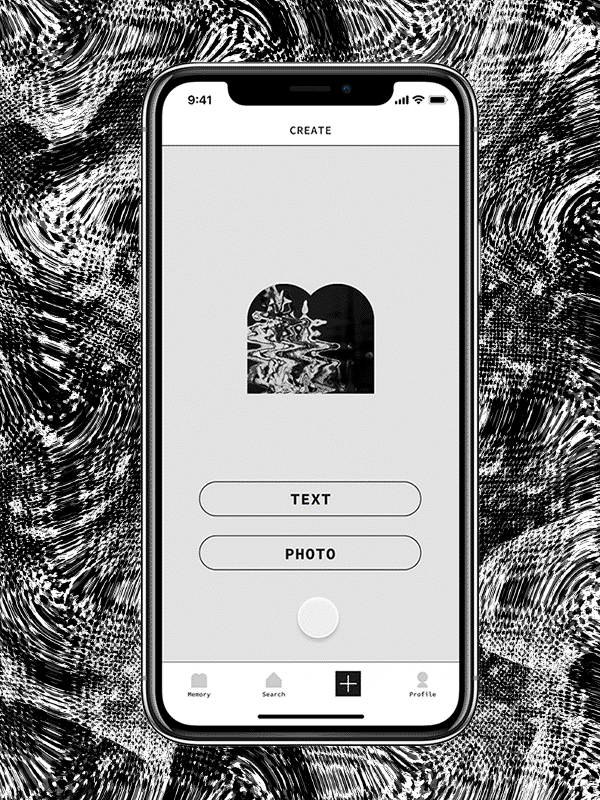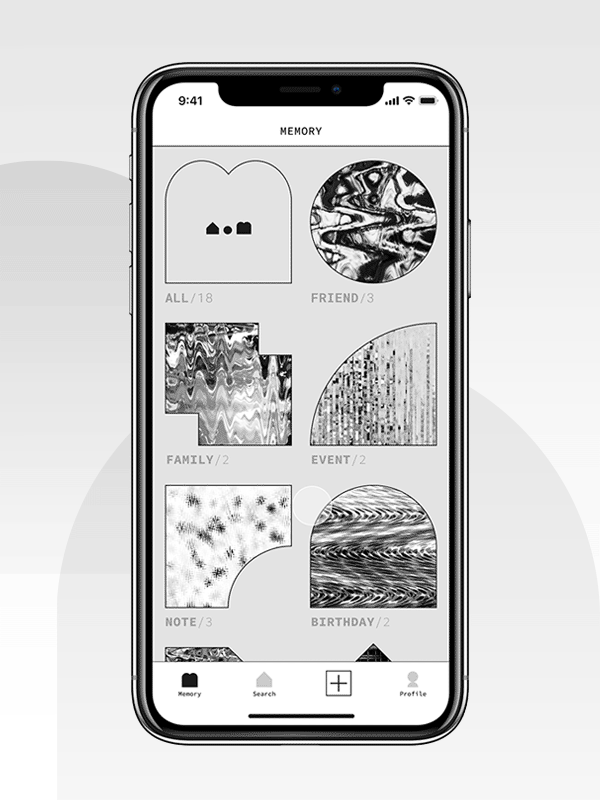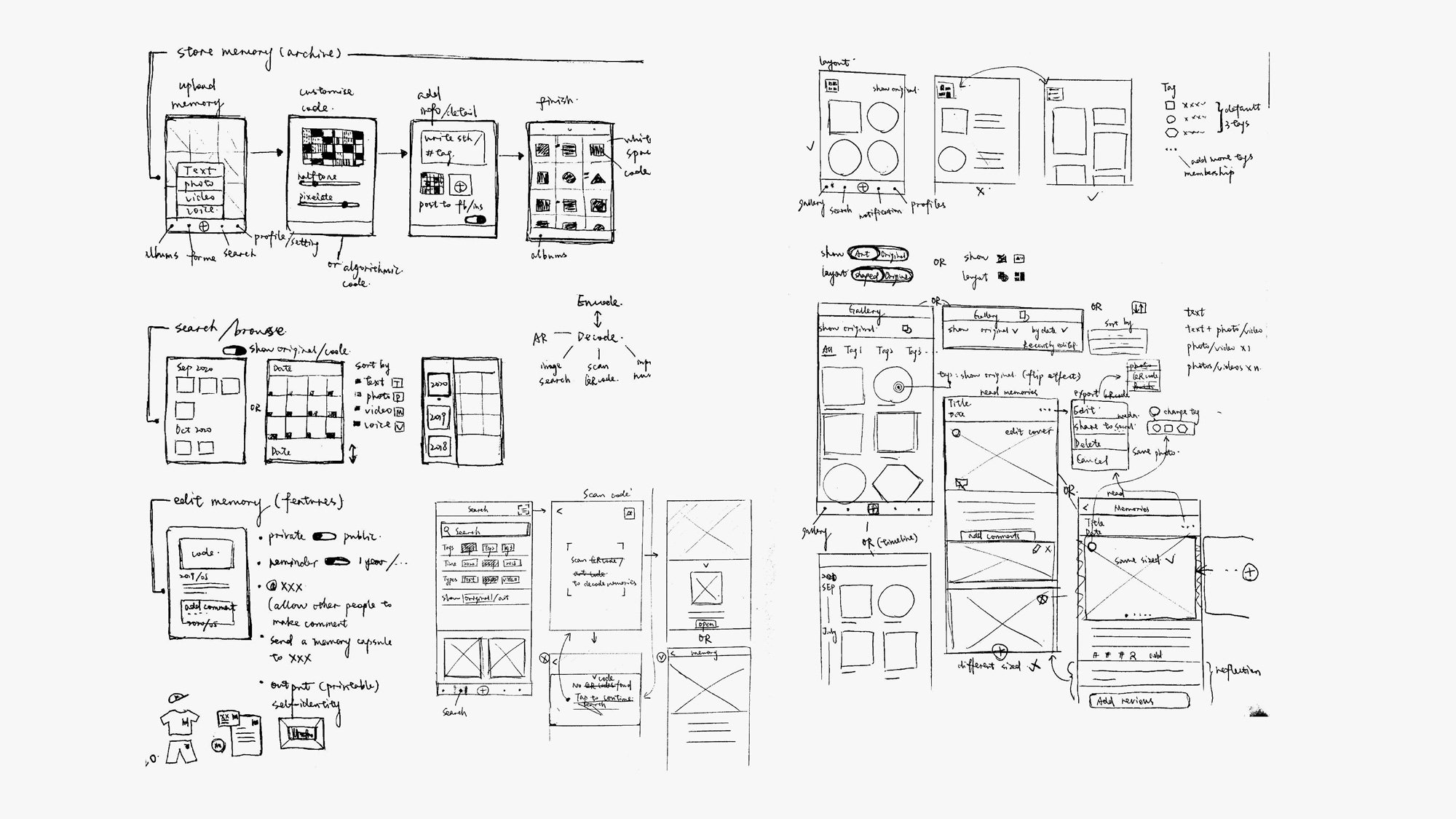An experimental art project of memory visualisation
Art of Memory is a personal project aims to inspire people to revisit memories through a new lens of art that evokes new emotional associations and varying interpretations.
Challenge
Investigate a method of transforming memories into abstract artworks with the help of creative technologies
Info
Personal project (Aug - Oct 2020)
My role | UX Research, UI Design, Graphic Design, Creative coding
Deliverables | Mobile App, Abstract Artwork
Project
Background
Memory is a time machine that allows us to travel backwards and look ahead into the future. However, some people who dwell on bad memories are not able to move on, which can cause sadness, depression or despair.
-
According to the study, one of the effective treatments on this issue is to help people think and feel from different perspectives. So my initial idea was to empower people to connect with our memories by transforming negative emotions into positive results.
Methodology &
Design Process
Exploratory Research Methodology was conducted to gather information and knowledge to solidify the new topic around memory and back up my design hypotheses.
-
Design Thinking Process guided me to continuously triangulate insights into design experiments towards appropriate solutions.
-
To deepen my understanding of how people think about and deal with negative memories, I had casual conversations with my classmates. The insights below shifted my idea from ‘removing unwanted memories’ to ‘changing our thought patterns’.
-
1) We can’t erase bad memories. We keep them somewhere, as a record of what we have experienced;
2) Our past brought us to where we are today;
3) People make a rational rather than an emotional choice about uncomfortable memories. -
In this project, the primary type of memory is defined as Episodic Memory - the memory of everyday events and the collection of past personal experiences. To understand how people tell past stories, 10 people in school were invited to write or draw their precious moments. And results showed that most of participants shared happy memories of family and friends.
-
I used observation as a method to empathise and analyse What, How and Why we record daily life using different tools?
-
I found that people store thoughts and feelings mainly for reminiscence and expression, which helped me identify the design opportunities in the area of art and memento through various mediums. -
As human memory is a science and philosophy subject, I learned foundation knowledge of how memories form and work to backup my further design experiments and decisions.
-
It’s interesting to know that memory is a reconstructive process that is biased and edited by how we perceive both ourselves and our experiences. And my proposed solution that creating new associations with old memories through abstract art forms is also supported by expert opinions that engaging with the visual arts helps enhance memory while reducing stress and negative emotions.
Technical & Visual
Experiments
My design process started with technical exploration on drawing, creative coding and photo editing, aiming to find a feasible technology to visualise memories creatively and aesthetically .
-
The visual direction of art outcomes is inspired by inkblot art, generative art and data visualisation.
-

1. Visual Cues
Media | Digital painting
Objective | Focus on exploring how abstract elements could be used as visual cues to evoke emotional response and memories -

2. Abstract Pattern
Media | Drawing & Coding
Objective | Design abstract patterns to visually represent the reconstructive and dynamic process of memory -

3. Geometric Symbol
Media | Data Visualisation & Coding
Objective | Make patterns meaningful and personalised by using relevant data to ‘quantify’ our memories. (A series of geometric symbols was designed to depict and record personal experiences.) -

4. Organic Visual Style
Media | Coding
Objective | Shift visual style from artificial to organic for better emotional storytelling. (These texture and brushstroke style are created by basic geometric elements such as line, circle and rectangle) -

5. Rasterised Image
Media | Coding
Objective | Build a better connection with our memories by interacting with original photos. (This experiment gave me an idea of building a digital tool that makes it easier for everyone to experience.) -

6. Patterned Image
Media | Coding
Objective | Having a defined visual direction, I experimented with various image filter combinations in Photoshop to design new presets that could be applied to process both photos and text.
Ideation
Based on insights from research and design outcomes from technical exploration, the proposed solution was to design a digital product that enables people to transform memory into artwork.
Target Audience &
Journey Map
The ideal user group is young adults aged 18 to 30 who are looking for new ways to preserve and revisit curated memories.
-
The journey map demonstrates the way users could interact with the App. The entire journey includes three stages cross both digital and physical channels.
Visual Solution
Abstract Art
The visual direction of art outcomes is abstract patterned visuals in black-and-white. It creates a mysterious and imaginative feeling that gives new meaning to the original content.
-
Feedback from target audiences:
They were interested in seeing their memories being portrayed in this artistic way. They have different preferences on patterned styles, but most of them prefered the black-and-white look over coloured effects.
Digital Solution
Mobile App
This digital tool is an artistic visual archive of curated memories that empowers user to transform photos or written content into aesthetic artworks. It also provides user with a private and safe place to express their emotions and thoughts.
Function 1: Creative Tool
Convert image / text into artwork with artistic filters and customised presets
Portraying ordinary Photos in an artistic way
Converting text into patterned image
Function 2: Visual archive of memories
Preserve all curated memories in both original and artistic format and categorise into albums
1. Organise memories into geometric albums
2. Sort by Date or Name
Shift to the original view mode
Design Refinement
Paper sketch was used in the early stages of design process to quickly visualise new ideas and lay out some key features.
The functions and UI design of the app got into further detail based on the testing results from target users.
The improved searching process
More organised and clean look
The simplified editing process
Print Solution
Personalised Memento
To create an emotional bond with our memories across multiple channels, I would like to develop a customised photo-printing service to enrich the entire experience. Through the application, users can upload finished artwork and turn their digital memories into physical mementos such as art prints, home decorations, tailored clothes, and more.
Project
Summary
The main contribution of this project lies in the intersection of art, design and technology. It investigates a creative approach to revisiting our past by changing perspective through the interaction with abstract art and digital tools. Meanwhile, the technical experiments in my design process explore the potential of embedding creative coding into the field of digital art.
Opportunities:
1. Video Background Blur
Apply the abstract visual effect into video conferencing tools as a new background blur filter
2. The link between memory and self-identity
Develop this app to be fully functional where people can transform personal memory into artistic momentos for self-expression and self-presentation

























